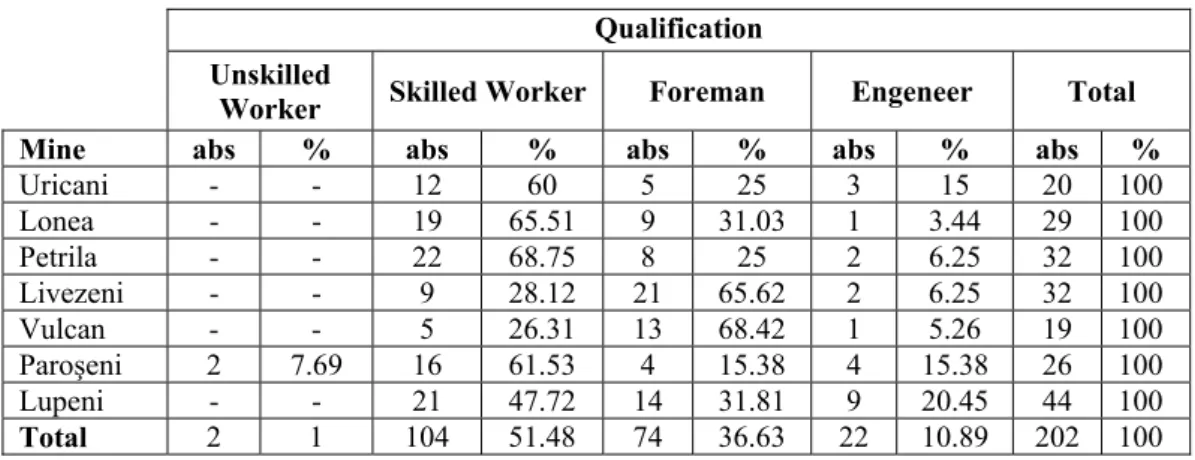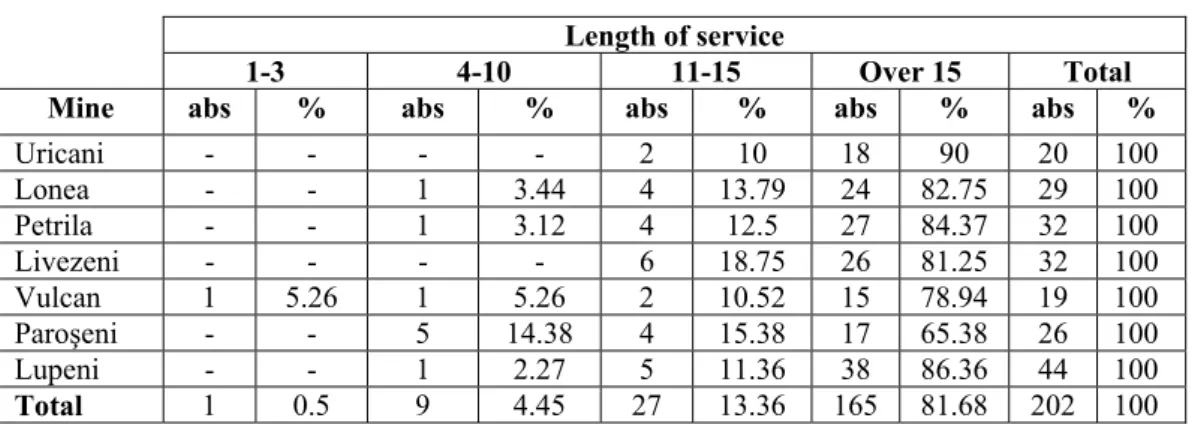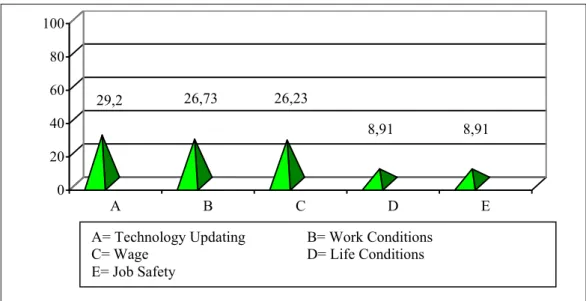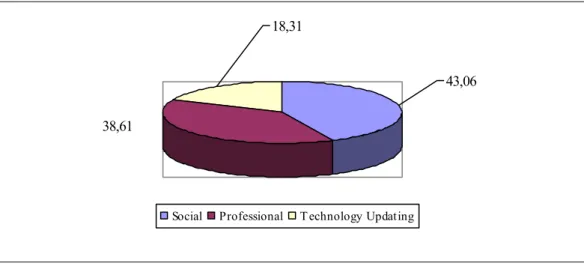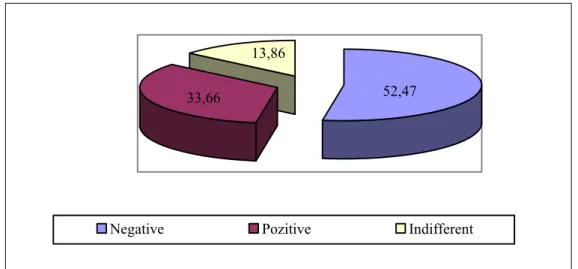Annals of the University of Petroşani, Economics, 11(1), 2011, 59-70 59
THE INFLUENCE OF THE MINING UNIONS OVER THE
EMPLOYEES’ SOCIO-ECONOMICAL CONDITIONS
IN THE JIU VALLEY
VASILE CIOCODEIC , ROBERT PRODANCIUC
*ABSTRACT: In this paper we tried to capture several realities that are present in the Jiu Valley and also tried to have a deeper comprehension of them by analyzing the present reality through the premises set by the past actions. The first step was to present the general situation of the Romanian union world. After that, we used a historical perspective over the present situation of the mining unions in the Jiu Valley and their becoming. We ended the paper with some conclusions drew from a research on a representative sample of miners from the Jiu Valley mines. We statistically analyzed their perceptions regarding the way they feel about the unions and came up with some pretty interesting conclusions.
KEY WORDS: the Jiu Valley; mining; union; confederation; socio-economical status; employees’ interest promotion.
JEL CLASSIFICATION:J51.
1. UNIONS IN ROMANIA
There are several trade union federations and county unions affiliated with one of the great union confederations in Romania. The most famous union confederations, which are recognized at the tripartite negotiations between the government, the unions and the employers, by the C. E. S. body (Consiliul economic şi social – The Economic and Social Council), are (www.util21.ro):
1. C.N.S.L.R. – Confederaţia Naţională a Sindicatelor Libere din România – Frăţia (The Romanian Free Unions National Confederation – The Brotherhood);
*
Assoc. Prof., Ph.D., University of Petroşani, Romania, vasileciocodeica@gmail.com Assist. Prof., Ph.D. Student, University of Petroşani, Romania,
robertprodanciuc@yahoo.co.uk
60 Ciocodeică, V.; Prodanciuc, R.
2. B.N.S. Blocul Naţional Sindical (The Unions National Group);
3. C.N.S.C.A. – Confederaţia Naţională Sindicală Cartel Alfa (The Unions National Confederation Alfa Cartel);
4. C.S.D.R. – Confederaţia Sindicatelor Democratice din România (The Romanian Democratic Unions Confederation);
5. C.S.N. Meridian – Confederaţia Sindicală Naţională Meridian (The National Unions Confederation Meridian).
The Romanian Union world is changing (Enache, 2007). After the merger of the biggest union confederations from Europe, the most important Romanian unions are observing the same pattern. Four of the most powerful union confederations in our country - CNSLR – Frăţia, BNS, CSDR and Meridian are to make up The General Work Confederation.
The interests of over a million and a half people will be represented by only one body that will be named The General Work Confederation. There has been talk of these changes in the Romanian union world for some time. A couple of years ago BNS and CNSLR – Frăţia had some high level talks about a possible merger. At that time, though, nothing happened, the two union members gave up the idea because of the pride of some of their leaders. Mean while, there have been some important international changes, that have climaxed with the merger of two of the largest union confederations from Europe. The International Free Unions Confederation (CISL) and the International Work Confederation (CMT) made up a huge union, with over 200 million members. In this context, the representatives of the employees organizations from our country realized that faced with globalization, they cannot remain divided. The talks restarted and the general agreement was that the merger had to be done as soon as possible.
2. THE UNION STRUCTURE OF THE JIU VALLEY MINING
The trade union phenomenon from the Jiu Valley developed under the conditions of informational deficiencies, as well as incorrect social perceptions regarding the social problems of the genuine democratic countries, with a policy dominated by several parties, with a free market economy and a civil society based on humans’ fundamental rights and on the background of political, social and economical events that marked the union actions and the relations of the union with the management of R.A.H. (Regia Autonomă a Huilei – The Autonomous Mineral Coal Company).
The institutional and power void in 1990 made the mining unions get organized and form claim platforms that were met by the Government too easy.
The Influence of the Mining Unions Over the Employees’ …
61the budget for the mines and preparations rebuilding and conservation and the first interference in the management of the Coal Company (
Ciocodeic
ă
, 1998
).The delays of the decisional factors from Bucharest in handling these claims led to the first miners strike at Vulcan in March 1990. Under the pressure of the miners delegation led by Miron Cozma (employee of Lonea Mining Company back than) and also with elections purposes, the Government gave up too easy and institutionalized new rights for the miners through Decision No. 267 from the 14-th of March 1990, signed by the Prime-minister Petre Roman.
As a result, the miners feeling that they were favored by the political power and not wanting to lose a government that supported them, in June 1990 went to Bucharest to stop the “University Square” phenomenon. The aggressiveness and the violent character of the events of the 13-th – 15-th of June 1990 were determined by the macro-social reshaping, by the political interests but also by the failure of the Government to find a different approach that of manipulation and generating wrong perceptions and deformed visions regarding the conflict situations that marked that period (Vlãsceanu, 1993).
The period that followed up to September 1991 was marked by aspects that influenced and maintained a climate of social tension in the Jiu Valley.
The “success” obtained in June 1990 generated an unnatural balance of force in the relations between the Jiu Valley Mining Union League (LSMVJ) and the management of the Mining Company. Looking back objectively, we must underline that the management of the Coal Company proved to be weak and incompetent giving up on countless occasions to the pressure of the union leaders, accepting the change of some top managers (the general manager of Lupeni Mine, the head engineer of Lonea Mine), although they were considered to be good professionals and strict in observing the financial discipline (Comisia parlamentarã de anchetă a evenimentelor din septembrie 1991, 1992) and even declining their competence totally or partially in favor of the unions in order to solve some problems of the Company like: technology updating, investments, supplying. There were also tacit agreements in between the Union and the Company to obtain funds from the budget in the interest of increasing the wages.
In regard to all these, the movement to Bucharest that took place in September 1991 cannot be blamed on the Company management which, in order to do away with the tense situation in the Jiu Valley, agreed to all the claims of the miners. The political factors marked a group of people that was easy to manipulate.
After the strike of September 1991 the management of the company agreed to all the demands of the union at the negotiations of the first collective work contract for 1991-1992 having, verbal or writing approvals from the decision factors from Bucharest, with the granting of funds from the budget, thus up to 1993 the Company had no financial loss.
62 Ciocodeică, V.; Prodanciuc, R.
Company reasoning that the approved budget is not allowing any wage increases is pointing towards the Government for a solution.
On the 2-nd of August 1993 the miners had another strike. Once again, the Government proved political indecisiveness and found resources and solutions to most of the strikers’ demands.
It must be pointed out that this time the legal procedure of a general strike was observed in an attempt to prove that the union leaders matured and are willing to accept a face to face dialogue. This time also there were destructions, especially at the Company headquarters, where the personnel were deterred from doing their job.
Giving up to the demands of the Union is continued on behalf of the Company as well as the Government with obvious repercussions on the financial situation of the Company. The first negative financial results are registered at the end of 1993, although they are small about 5 milliard lei, they continue to build up over the first six months of 1994 – about 9 milliard lei. In regard to all these, the balance sheet of the Company was almost balanced and there were financial resources to recover. The collective work contract negotiated for 1994-1995, effective of the 1-st of July 1994, which introduces the fidelity wage increase calculated by applying a percentage of 40% to the base pay, as a way to increase the wages and the agreement of the Company Administration Board, is leading towards the beginning of the end of a normal financial situation, thus at the end of 1994, the Company registered a loss of 179 milliard lei, loss that grew over the next years.
As observers to the events that took place back than we must point out the fact that the Administrative Council of the Company had verbal agreements from the Government to sign that ill-fated collective work contract, based on promises that a supplementary subvention from the budget will be received up to the end of 1994, subvention that would cover the financial demands of the unionists, but the supplementation was not approved accepting though that the Company would not pay off the debt to the state budget.
Regardless of the constitution of the Company’s Administrative Council, as long as it didn’t have the support of the Government, the union pressure was unstoppable. Further more, by address no 180923/21.03.1995 sent to the Company by the Ministry of Industry points towards some dysfunctional relations between the unions and the administration and underlines that „the union problems must be understood and treated with all the required attention in order to prevent conflict situations from appearing”.
At the same time realizing that any financial request of the Company will not be met until the unions intervene on imperative tones, the leadership of the Union starts to pose as the leadership of the Company, intervenes to the decision factors from Bucharest and on most occasions gets what it wishes and also organizes work meetings with members of the Government in order to solve the financial problems of the Company.
The Influence of the Mining Unions Over the Employees’ …
63phrase belonging to Miron Cozma – the Union leader: “We promise a new beginning. We direct your attention towards the fact that if there will be any talk about closing down any Romanian mine, than this will really be a new beginning. The miners are making common cause and that is well known”.
None of the problems raised at the meeting in March 1995, in Petroşani was solved, so the Jiu Valley mining unions requested and organized a new meeting on the 9-th of November 1995. This time the meeting is taking place at the Government headquarters. The tone of the discussions is set once again by Miron Cozma, but also the Finance Minister who is making declarations that are to create future conflicts.
As a result of the promises made by the Government, any Union demand that isn’t met by the Company is resulting in blame over the Company that is considered to be incapable of obtaining what the Government promised.
In 1996, analyzing the financial situation of the Company, the Administrative Council is trying without any success to stop the wage increases and while the general manager of the Company was on the waiting list at the Ministers, Miron Cozma was “solving” the economic problems of the Company closing deals that had no finality and being deceived by the leaders of the Government. All these things generated the miners strike on the 30-th of July 1996 that ended by approving all the demands by the Finance Minister Florin Georgescu. Once again the Administrative Council of the Company was considered incompetent by the miners. At the end of 1996 the financial loss of the Company was 747 milliard lei reflected into debts at the state budget and without any chance of ever being paid off.
In 1997, the Minister of Industry, continuing to consider that the blame for the disastrous situation of the Company is on the Administrative Council, is appointing a general manager from Bucharest, Gheorghe Rancea, which proves to be an even worst manager than his predecessors. After the miners strike of June 1997, he leaves for Bucharest. As always, at the negotiations between the unions and the Government the Administrative Council is ignored. The requests of the unions are quickly approved by the new Government. The results are losses of over 1000 milliard lei only for 1997. Also it is important to mention that the miners’ leader, Miron Cozma, has been in prison since January 1997. For the union requests there are always new leaders ready to take his place but they aren’t able to maintain there power.
After the personnel lay offs of September – October 1997, that lead to a decrease of the number of miners to almost half, it looked like the relations between the unions and the Company management would finally normalize. The ones that remained to work in this sector realized that the Government is not protecting them any more. The new Government elected in November 1996 didn’t consider mining to be a priority and subventions from the budget are cut down wanting to eliminate them completely. Surprisingly the collective work contract for 1998-1999 is also extremely disadvantageous for the Company.
64 Ciocodeică, V.; Prodanciuc, R.
that the managers of the Company wanted to maintain their jobs, social status and wages giving up too easy and without any grounding to the union demands.
After the miners’ strikes of January and February 1999, followed by the arrest of Miron Cozma and of other union leaders, the strength of the Union League collapsed. It all culminated with the rip of 2005 when three powerful unions detached from the Union League and set up The Mines and Energy Union Association which is affiliated to the confederation ran by Marin Condescu.
3. THE RESEARCH METHODOLOGY
The analysis of any given situation is first of all based on the objective data of the reality hereof. For the social protection we took into account the real number of individuals that benefit from it, the available funds and the used funds, the type of expenditures that are made, their real structure, their legal basis etc. The sources of such an analysis are the statistical data, balance sheets, legal rights, the collective work contract etc.
But the objective reality is doubled by its subjective reflection into the peoples’ consciousness. In other words, it is important to know not just that there are certain funds that are used in certain ways. It is more important to know what the people think about these actions, what there motivations are, what is their satisfaction – so we are interested in knowing what their attitude is toward the social protection that they are offered.
The only way in which we can grasp the attitude is by surveying people opinions. There is a difference in between attitude and opinion: the attitude is more profound and fully engages the individual’s personality while the opinion is more superficial and often fluctuates.
The research methodology used had a complex character, combining the use of several techniques of data gathering: the document analysis of some statistical situations and of the data regarding the work force; observations regarding some realities from the mining companies and the union activity; sociological interview on a sample of employees.
The volume of the sample was made up of 2% of the total population (of over 10,000 employees). As sampling technique, we used non-random multistage sampling. The build up of the sample was done in two stages:
a) Establishing the statistical weight that the employees of different mining companies are going to represent in the final sample. First of all the percentage of employees of each of the seven mining companies was calculated out of the total number of seven mining companies. The total number of employees from each mining company that make up the final sample is: Lonea 29, Petrila 32, Livezeni 32, Vulcan 19, Paroşeni 26, Lupeni 44, Uricani 20.
b) Establishing the other criteria for the sampling. We considered two main criteria – age and qualification – so we ended up with four quotas.
The Influence of the Mining Unions Over the Employees’ …
65The age criterion was used out of operability reasons, but also because it usually implies a certain length of service. The qualification had only two categories also out of operability reasons.
In respect of any sociological research demands, the anonymity and confidentiality principles were observed.
We will now present the investigated population having as criteria the factual variables just as it was identified after the sampling.
We also specify that the percentages haven’t been rounded in order to try to be as objective as possible.
Table 1. The Age Structure of the Population
Age
Under 35 36-45 Over 45 Total Mine abs % abs % abs % abs %
Uricani 3 15 15 75 2 10 20 100 Lonea 8 27.78 15 51.72 6 20.68 29 100 Petrila 5 15.63 24 75 3 9.37 32 100 Livezeni 2 6.25 18 56.25 12 37.5 32 100 Vulcan 3 15.78 14 73.68 2 10.52 19 100 Paroşeni 6 23.07 17 65.38 3 11.53 26 100 Lupeni 7 15.90 33 75 4 9.09 44 100 Total 34 16.83 136 67.32 32 15.84 202 100
Table 2. The qualification structure of the population
Qualification
Unskilled
Worker Skilled Worker Foreman Engeneer Total
Mine abs % abs % abs % abs % abs %
Uricani - - 12 60 5 25 3 15 20 100 Lonea - - 19 65.51 9 31.03 1 3.44 29 100 Petrila - - 22 68.75 8 25 2 6.25 32 100 Livezeni - - 9 28.12 21 65.62 2 6.25 32 100 Vulcan - - 5 26.31 13 68.42 1 5.26 19 100 Paroşeni 2 7.69 16 61.53 4 15.38 4 15.38 26 100 Lupeni - - 21 47.72 14 31.81 9 20.45 44 100
Total 2 1 104 51.48 74 36.63 22 10.89 202 100
66 Ciocodeică, V.; Prodanciuc, R.
This situation is mostly due to the fact that at this mine has workers that that came from other units that were closed down.
The qualification structure is representative to the qualification structure of all the units of the National Mineral Coal Company. Most of the people working at these units have graduated a middle level school (vocational or secondary school) and they are employed as skilled workers as well as a smaller part of the people that have higher education. The most important need of all the mining units is for people that would do heavy physical labor. There are also situations in which a certain subject has graduated some university and is not employed on a job that requires such a high level of education, but these isolated cases are exceptions.
Table 3. The length of service structure of the population
Length of service
1-3 4-10 11-15 Over 15 Total
Mine abs % abs % abs % abs % abs %
Uricani - - - - 2 10 18 90 20 100 Lonea - - 1 3.44 4 13.79 24 82.75 29 100 Petrila - - 1 3.12 4 12.5 27 84.37 32 100 Livezeni - - - - 6 18.75 26 81.25 32 100 Vulcan 1 5.26 1 5.26 2 10.52 15 78.94 19 100 Paroşeni - - 5 14.38 4 15.38 17 65.38 26 100 Lupeni - - 1 2.27 5 11.36 38 86.36 44 100
Total 1 0.5 9 4.45 27 13.36 165 81.68 202 100
Closely connected to the subjects’ age is their length of service. Due to the socio-economical situation of the Jiu Valley, especially after the lay offs and of the unemployment rate in the area, in most of the cases the length of service that the subjects declare is totally in the mining sector and even in the same unit. The smallest percentages are registered at the 10 to 15 years. These people are young; their age is up to 35 years old. The last part of the interval is represented by people that have worked for over 15 years and is the best represented sector.
The explanation for this situation can be found in the fact that the National Mineral Coal Company hasn’t employed any personnel for a long time, the lay offs are constant and as a result the average age as well as the average length of service are higher. It can also be observed a certain “professional ageing” of the employees.
The good news is that there are a high percentage of personnel that has a longer length of service and that also means that there are more experienced professionals. Besides the positive aspect, we can also notice a certain amount of conservatism and reticence towards everything that is new and means change.
The Influence of the Mining Unions Over the Employees’ …
67some families in the Jiu Valley is more complex and complicated because in most of the cases when only one adult of the family is working, if that person were to lose his/her job, were to suffer a work accident or were to have his/her work ability impaired, than the situation of all the family becomes extremely precarious.
Table 4. The marital status structure of the population
Marital Status Not Married Married Married and
having children
Other Total
Mine abs % abs % abs % abs % abs %
Uricani 2 10 7 35 9 45 2 10 20 100 Lonea 3 10.34 14 48.27 12 41.37 - - 29 100 Petrila 1 3.12 10 31.25 21 65.62 - - 32 100 Livezeni 4 12.5 12 37.5 16 50 - - 32 100 Vulcan 2 10.52 5 26.31 12 63.15 - - 19 100 Paroşeni 3 11.53 8 30.76 15 57.69 - - 26 100 Lupeni 1 2.27 16 36.36 27 61.36 - - 44 100
Total 16 7.92 72 35.64 112 55.44 2 1 202 100
4. THE UNION ACTIVITY AND ITS EFFECTS
From the analysis of the answers received at the questionnaire comes out the fact that the most important problems for the Union are: technology updating, work conditions, wage, life conditions, and job safety.
29,2 26,73 26,23
8,91 8,91
0 20 40 60 80 100
A B C D E
Figure 1. The Most Important Problems for the Union (%)
68 Ciocodeică, V.; Prodanciuc, R.
Almost half of the subjects agree that the social problems are the ones that the Union should mainly focus on solving. On the second place in the subjects’ choices with a small difference (38.61%) from the first is another subject that should be of focus for the Union – professional problems. Third and last choice is the problems of the technology updating.
18,31
38,61
43,06
Social Professional T echnology Updating
Figure 2.The Most Important Problems that the Union Should Take Care of (%)
Most of the subjects, regardless of the mining unit that they work at, assert that their interests are not being promoted enough by the Union (64.35%).
59,09 40,9
75,86 24,13
68,75 31,25
62,5 37,5
80 20
50 50
42,1 57,89
0% 20% 40% 60% 80% 100%
Lupeni Lonea Livezeni Petrila Uricani Paroseni Vulcan
Insufficient Normal
The Influence of the Mining Unions Over the Employees’ …
69More than half of the subjects agree that the effects of the fact that there are five unions are negative. Taking into account that a unitary approach of any problem by five independent union bodies is impossible, the results of negotiations could differ more or less and under these conditions the consequences could be altercations and professional conflicts that are not beneficial for any professional activity in general. The next represented opinion with 33.66% is of the people that say that the effects of the existence of five unions could be beneficial. The smallest percentage of 13.86% represents the subjects that declare to be indifferent towards this problem.
52,47 13,86
33,66
Negative Pozitive Indifferent
Figure 4. The Effects of the Existence of Five Unions (%)
The percentages that define the social services that they would give up in case the Company couldn’t afford to provide any more are close but define different realities. Most of them are related to the wages. The first percentages are related to the cooked meal that they are not to happy about but still, they wouldn’t give it up. They tend too agree that the holydays premiums are a little welcomed financial help that rounds their incomes and as a consequence they wish to keep them. Due to the fact that part of the subjects have their jobs in other locality than where they live, it is only normal that they do not wish to give up the free of charge transportation. Most of the subjects cannot imagine giving up the safety equipment that assures their work security and is a vital component of the technology updating process.
REFERENCES:
[1]. Ciocodeic , V. (1998) Relaţia patronat-sindicat, Editura Fundaţiei ,,I.D. Sârbu”, Petroşani
[2]. Enache, S. (2007) Sindicatele “globalizează” piaţa muncii, Săptămâna financiară, no.137, Monday, the 19-th of November
[3]. Rotaru, T.; Iluţ, P (1996) Sociologie, Second Edition, Editura Mesagerul, Cluj-Napoca
70 Ciocodeică, V.; Prodanciuc, R.
[5]. Zamfir, C.; Zamfir, E. (1995) Politici sociale, Editura Alternativa, Bucureşti
[6]. Comisia parlamentar de anchet a evenimentelor din septembrie 1991 (1992) Raport privind cercetarea evenimentelor violente desfăşurate în zilele 23-28 septembrie 1991, Parlamentul României, , Bucureşti
[7]. Confederaţia sindicală din România, carteluri şi sindicate naţionale, www.util21.ro [8]. Protecţia socială la Regia Autonomă a Hulei Valea Jiului, contract de cercetare ştiinţifică
nr.2/1996 încheiat între Universitatea din Petroşani şi R.A.H.
[9]. Stenograma întâlnirii dintre liderii organizaţiilor sindicale din Valea Jiului şi reprezentanţi ai Guvernului României, 9 noiembrie 1995
